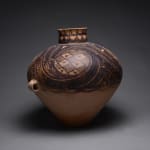Neolithic Yangshao Painted Terracotta Vessel, 3000 BCE - 1500 BCE
Painted Terracotta
height 41.3 cm
height 16 1/4 in
height 16 1/4 in
H.801
Further images
Many thousands of years ago, our earliest ancestors were nomadic tribes that survived by foraging the wild for food and shelter. During the Neolithic era, human groups first began to...
Many thousands of years ago, our earliest ancestors were nomadic tribes that survived by foraging the wild for food and shelter. During the Neolithic era, human groups first began to settle down permanently, establishing villages and communities. However, without new technological innovations, this sedentary culture would not have been possible. Foremost among these discoveries were agriculture and tool-making, both of which enabled humans to transform their natural environment into a sustainable society. Many thousands of years ago, the area presently covered by modern China was made up of distinct regions each with their own unique cultural identity. Archaeologists have been able to discern some of these cultures from each other based upon the burial styles, architecture, and pottery, perhaps the most immediate remnant of this age.
When Neolithic mankind began to settle in areas further removed from sources of water, transportation of this vital fluid became a foremost necessity. After unsuccessful attempts to create water resistant vessel from wicker baskets caked in mud, pottery was invented. The creation of pottery in China dates back as early as 6000 B.C. when villagers first realized that the earth around fires became hard and impervious to liquid. From this realization came the birth of pottery, fulfilling the practical necessity of water transportation and allowing civilization to expand. While pottery was created to answer a need, it soon progressed to be more than functional: it was also beautiful. While Neolithic vessels would have been used to carry water or to store grains, they are also spectacular artistic creations. The forms of the vessels, built up from coiled clay, are elegant and refined.
The generic name for the Neolithic culture that created these vessels is Yangshao (3000-1500 B.C.). They are thought to have been the first to harvest silk from the silkworm, initiating a tradition the Chinese are still famous for today. While few specifics are known about the Yangshao culture, information gathered from archaeological excavations of tombs and tribal villages has provided a rudimentary vision of life in prehistoric China. Furthermore, the geometric paintings that decorate Neolithic vessels represent some of the earliest evidence of the origins and evolution of calligraphic writing in China. While these designs are purely abstract and in no way constitute a written language, the patterns, motifs, and application of paint all serve to give us insight into the intellectual and aesthetic atmosphere that would eventually foster the creation of Chinese symbols.
As is typical of similar works, the upper half of this vessel is painted with abstract designs while the lower portion is left unfinished. Painted in red and black, a pattern of swirling lines surround circles filled with a diamond checkerboard motif. Although this vessel was originally created to serve a practical purpose, today it is appreciated as a gorgeous work of art, treasured both for its beauty and history alike.
When Neolithic mankind began to settle in areas further removed from sources of water, transportation of this vital fluid became a foremost necessity. After unsuccessful attempts to create water resistant vessel from wicker baskets caked in mud, pottery was invented. The creation of pottery in China dates back as early as 6000 B.C. when villagers first realized that the earth around fires became hard and impervious to liquid. From this realization came the birth of pottery, fulfilling the practical necessity of water transportation and allowing civilization to expand. While pottery was created to answer a need, it soon progressed to be more than functional: it was also beautiful. While Neolithic vessels would have been used to carry water or to store grains, they are also spectacular artistic creations. The forms of the vessels, built up from coiled clay, are elegant and refined.
The generic name for the Neolithic culture that created these vessels is Yangshao (3000-1500 B.C.). They are thought to have been the first to harvest silk from the silkworm, initiating a tradition the Chinese are still famous for today. While few specifics are known about the Yangshao culture, information gathered from archaeological excavations of tombs and tribal villages has provided a rudimentary vision of life in prehistoric China. Furthermore, the geometric paintings that decorate Neolithic vessels represent some of the earliest evidence of the origins and evolution of calligraphic writing in China. While these designs are purely abstract and in no way constitute a written language, the patterns, motifs, and application of paint all serve to give us insight into the intellectual and aesthetic atmosphere that would eventually foster the creation of Chinese symbols.
As is typical of similar works, the upper half of this vessel is painted with abstract designs while the lower portion is left unfinished. Painted in red and black, a pattern of swirling lines surround circles filled with a diamond checkerboard motif. Although this vessel was originally created to serve a practical purpose, today it is appreciated as a gorgeous work of art, treasured both for its beauty and history alike.







